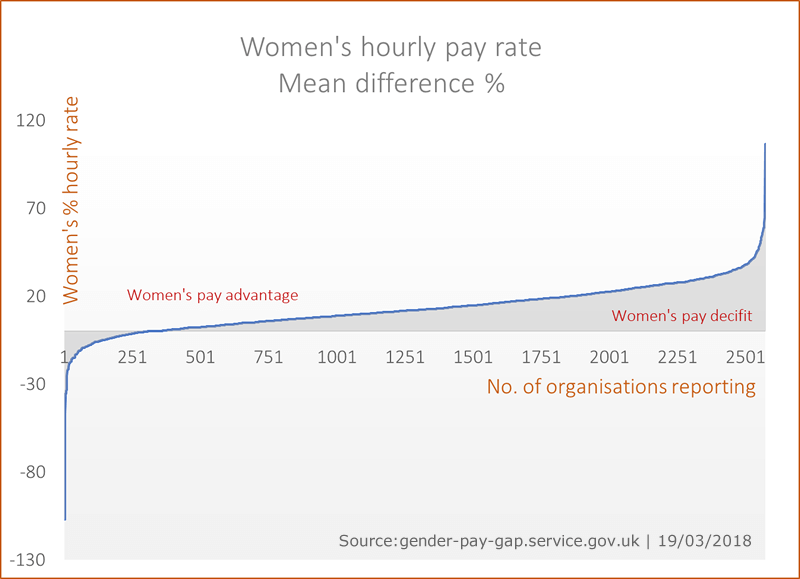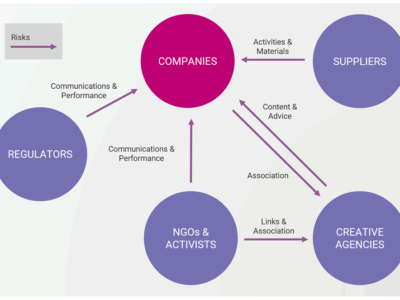“Virtue can only flourish among equals.”
Mary Wollstonecraft
All UK companies with more than 250 staff must report their gender pay gap by 4th April 2018. Of the 9,000 UK companies that are required to report their performance only 3,700 had done so on the 25th March, and more than 25% hadn’t even registered.
What needs to be reported? The Government requires figures for gender pay gaps in mean and median hourly pay, the same for bonuses and proportion of male and female employees in each pay quartile.
What are we seeing so far?
With so many companies still to report, the range so far is already huge, from c. 107 to -107% of mean gap in hourly pay. That means that in some organisations women’s hourly rate is 107% lower than men’s – and the opposite at the other end of the scale. So that’s OK then? Not really, the extremes at either end are the same but the distribution is highly unequal.
When digging further into the gender pay data an initial analysis of industry types reveals a few notable issues (as of 19/03/2018).
Within the top quartile (that’s to say where women are either not disadvantaged or relatively less disadvantaged) there are a number of public sector bodies. This maybe expected as public funds should be spent with a view on equality. At the other end of the scale in the lowest performing quartile there are a number of banks, other financial services companies and three airlines. Both examples are likely to be explained by a relatively high proportion of highly paid men in the workforce (i.e. bankers or pilots).
Assuming these companies are observing the Equal Pay Act (the data cannot directly tell us if they are or not), there appears to be a huge gender pay gap – why are there apparently so many more highly paid men in the workforce? The reasons appear complex and interrelated. Broadly they are thought to include a range of cultural factors:
- women disproportionately fulfill childcare and caring roles and are more likely to take leave, career breaks or work part-time. This seems to harm career progression and levels of pay.
- It has been suggested that women are generally less bullish about seeking progression, for example applying for more senior roles only where they have nearly 100% of the requested criteria – whereas men will apply when they have around an 80% match between skills and the stated requirements of the role.
- There’s a pipeline issue – women are less well represented in technical and science related (STEM) education and training. These areas are generally more highly paid but have poor representation of women. This is often called the “leaky pipe” and we explored this in an article looking at diversity and STEM careers.
What does this mean?
It’s complicated and doesn’t necessarily mean companies are contravening the Equal Pay Act, it’s more likely that lower paid roles are disproportionately occupied by women. It’s also been suggested that part-time working and a range of conscious and unconscious biases play a part.
Why does it matter?
Ethically, it’s not fair. In utilitarian terms research suggests that more diverse, equal and transparent organisations perform better. While it is difficult to assert a clear relationship between diversity and financial/business performance improvement, there nevertheless remains some compelling evidence on why more balanced and diverse organisations are more successful.
- A two year survey from Bersin by Deloitte found that more advanced and diverse companies had “3 times higher cash flow per employee over a three-year period” than lower performing companies.
- The McKinsey Report “Why Diversity Matters” highlighted research which suggests: “Companies in the top quartile for racial and ethnic diversity are 35 percent more likely to have financial returns above their respective national industry medians”. And that “Companies in the top quartile for gender diversity are 15 percent more likely to have financial returns above their respective national industry medians”.
- Catalyst’s 2007 report “The Bottom Line: Corporate Performance and Women’s Representation on Boards” found that businesses with more women board directors demonstrate a range of clear financial benefits in terms of enhanced return on capital, sales and invested capital.
Gender imbalance – not a good look
It’s long been an interesting phenomenon that if you look at the social and employment policies of most leading companies you would clearly see them as pioneers and upholders of the best liberal-humanist values. The challenge is not that the policies don’t indicate a commitment to equity of access and equality of opportunity, support for flexible working and an acceptance that different people bring different, valuable skills. It’s that, if the current data on the pay gap are correct, there is also a yawning chasm between company policies and their actual practice.
There are of course many reasons why different people get different pay, but at a structural level, the data so far show that companies and society as a whole have a long way to travel to deliver equality when it comes to employment, opportunity and reward.
DISCOVER MORE | Sustainability Issues
Carbon Neutral Communications
Despite considerable regulatory focus on carbon neutral claims, companies are still getting their communications wrong, so what is happening?
While many large companies now appear wary of making claims about carbon neutrality, we can still see considerable focus on these in the SME space, some …
Reputation risk and sustainability – who do you work with?
Reputation is widely regarded as one the most valuable assets of an organisation. Sustainability can also be an important contributor to both reputation and several dimensions of business value.
In this article we explore different dimensions of reputational risk, how it might be affected and how …
Sustainable Aviation?
On the 28 November 2023, the first long-haul passenger plane powered with ‘sustainable’ air fuel took off. SAF offers an ostensibly attractive path for decarbonisation for the airline industry – the lifecycle greenhouse emissions can be up to 70% lower than conventional fossil-based fuels.
While …
Greenwashing – dimensions of risk
Greenwashing – misleading communications on sustainability issues – has various dimensions of risk, but these are often overlooked, and their implications are insufficiently examined.
While greenwashing may appear as simply irritating, it actually causes a range of harm and presents multiple …
Sustainable transition – waiting for the underpants gnomes?
Dramatic changes are needed in business and industry to head off coming poly crises and build a prosperous future for the growing global population.
But plans for this ‘sustainable transition’ are few and far between and often lack credible substance to bridge the link between ambition and action. …
Avoiding strategic greenwashing – why your business strategy must be plausible
Worldwide regulators are tightening up on strategic greenwashing to protect consumers, business and market integrity. As further examples arise there is more, we can learn about what regulators will tolerate and what they require of companies.
Put simply, any leeway for general feel-good …
WEF Global Risks 2023 – What’s new and what’s changed?
While big picture environmental threats of climate change, nature loss and ecosystem collapse remain long term risks, geopolitical instability and the current cost-of-living crisis challenges present emerging challenges to the chance for global consensus and coordinated action.
The WEF (World …
2023 sustainable business trends and challenges – what to watch out for
From avoiding greenwashing to facing soaring business costs, 2023 is set to be a challenging year for most business leaders to navigate.
Regulators, customers and consumers have increasing expectations for good quality, consistent information on sustainability. Communication must be accurate and …
Sustainable value creation
Understanding the relationship between your organisation and the wider world, and identifying which issues, trends, dependencies and risks are material (important) to your business future is critical. Not just for measuring and managing impact, but also for developing resilience and responding to …
Something in the air – the burden of air pollution
Small particle air pollution – when will we clear it? PM2.5 (small particle) air pollution is one of the most harmful types for human health, exposure has been linked to heart and lung disease, mental health and many other conditions including stroke, cancer and mental health. Air pollution …













 The sustainability of profit – stop looking back
The sustainability of profit – stop looking back
Leave a Reply